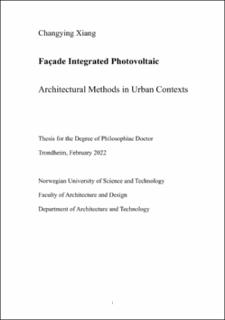Facade Integrated Photovoltaic-Architectural Methods in Urban Contexts
Doctoral thesis
Permanent lenke
https://hdl.handle.net/11250/3009171Utgivelsesdato
2022Metadata
Vis full innførselSamlinger
Sammendrag
The world’s leading economies including EU, US and China have set ambitious goals to achieve carbon-neutral societies by 2050 to 2060, which require large-scale implementation of clean energy systems. Building Integrated Photovoltaics (BIPV) is one of the most promising strategies to facilitate the clean energy demands. Besides the limited roof areas, the façade areas also demonstrated potential for solar energy capture and should be utilized for PV integration as well.
Façade integrated photovoltaic (FIPV) designs in urban contexts usually have high visibility for the public, and thus require holistic architectural integration. However, the number of current studies in this field is limited and most of them are focusing on the energy aspects. Aesthetic consideration like PV façade colors, texture and pattern is severely lacking. Therefore, this study seeks to explore advanced methods for FIPV from an architectural point of view. The environmental aesthetic is the main theoretical basis of this study, and mixed methods are employed as the research strategy throughout this study. Conducted as a PhD by publication, this study consists of 7 publications focusing on different topics related to architectural methods of FIPV, together with the overarching essay.
In the first stage, the focus was at the FIPV design criteria. Research gaps were sketched out, a series of aesthetic evaluation criteria for FIPV were proposed at both, building and urban levels. Then experimental studies investigating the colour angular sensitivity of opaque coloured PVs were carried out in NTNU’s artificial sky lab and outdoors, providing an in-depth understanding of colour properties of different PVs and corresponding architectural strategies.
In the second stage, a series of FIPV design methods were developed and tested. With a special focus on the colour aspect, a theoretical pixelization method for FIPV design was developed with Trondheim city in Norway as a case study. Local colour palette and colour harmony strategies were employed to generate pixelated FIPV designs-FIPV panels with different colours are integrated into the façades in order, and the generated overall façade images are perceived like mosaic or Neo-Impressionism style works. The design proposals were tested through an online aesthetic survey and a theoretical energy calculation model, demonstrating that a balanced FIPV performance including pleasing façade aesthetic, satisfying urban integration, and high energy production efficiency can be achieved. With a focusing aspect of balcony integration, another theoretical approach was generated to support the design of FIPV in open balcony areas of high-rise buildings, balancing the aspects of interior daylight, façade aesthetic, electricity generation and reduction of Greenhouse Gas emission.
Façade integrated photovoltaics is a promising strategy to support the realization of carbon neutralization in society. FIPV is still in the infancy of its development, and this PhD study sheds new light on advanced methods of generating FIPV from an architectural perspective. It could serve as a departure point for the development of new theories and strategies to promote this growing architectural trend demanding and enhancing the collaboration of architects, engineers, developers and users towards a holistic sustainable urban development.
